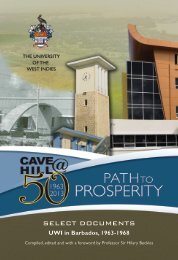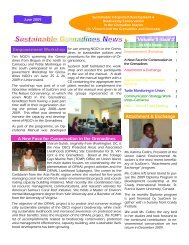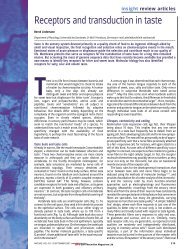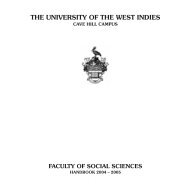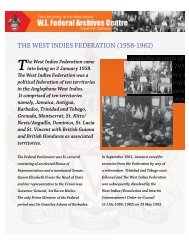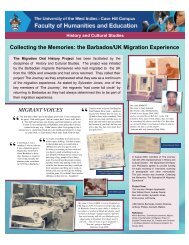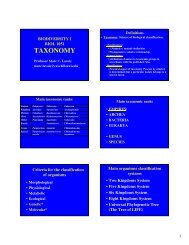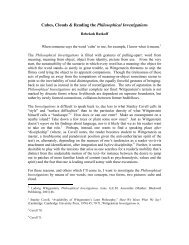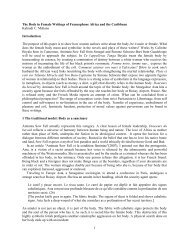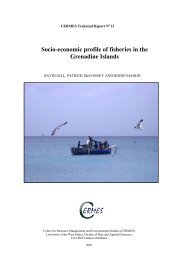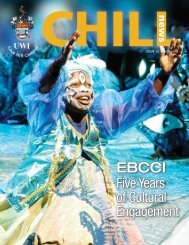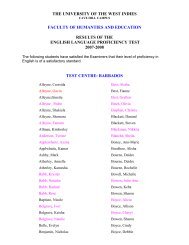THE SUSTAINABLE GRENADINES PROJECT - The University of ...
THE SUSTAINABLE GRENADINES PROJECT - The University of ...
THE SUSTAINABLE GRENADINES PROJECT - The University of ...
You also want an ePaper? Increase the reach of your titles
YUMPU automatically turns print PDFs into web optimized ePapers that Google loves.
Grenadine Islands - Annual Report For 2005. Clifton, Union Island, St. Vincent and the Grenadines. 42 pp.*<br />
This is a report on all the activities undertaken by the Sustainable Grenadines Project such as training courses, workshops,<br />
attachment and exchanges, mini-projects and other associated projects, among other things. <strong>The</strong> appendix contains the<br />
concept papers for various projects, brief reports <strong>of</strong> workshops and mini-projects.<br />
Sustainable Grenadines Project. 2005b. Sustainable Integrated Development and Biodiversity Conservation in the<br />
Grenadine Islands - Annual Report for 2005. Clifton, Union Island, St. Vincent and the Grenadines. 20 pp.*<br />
This work plan covers the period January 1st, 2006 to December 31st, 2006. It is based on activities identified during Phase<br />
1 <strong>of</strong> the project that were documented in the strategic plan, continuation and further development <strong>of</strong> activities carried out<br />
during the first year <strong>of</strong> Phase 2 <strong>of</strong> the project as described in the Annual Report for 2004-2005.<br />
Sutty, L. 1990 A Listing <strong>of</strong> Amerindian Settlements on the Island <strong>of</strong> Carriacou in the Southern Grenadines and a<br />
Report on the Most Important <strong>of</strong> <strong>The</strong>se, Grand Bay. In Proceedings <strong>of</strong> the 11th Congress <strong>of</strong> the International<br />
Association for Caribbean Archaeology, Puerto Rico 1985:242-259.<br />
Not seen<br />
Sutty, L. 1993. St. Vincent and the Grenadines. Macmillam Press Ltd. London. 108 pp.<br />
A brief overview <strong>of</strong> the first migrants, the Ciboneys, Arawaks, Caligvinies and Caribs, describes the flora and fauna,<br />
architecture, folklore and music <strong>of</strong> the islands. Details are provided for each <strong>of</strong> the Grenadines islands and travel, banking<br />
and accommodation information <strong>of</strong> importance to the visitors is appended.<br />
Sutty, L. 1998. A regional initiative to promote community based nature and heritage tourism, environmental<br />
education and conservation <strong>of</strong> island ecosystems in the eastern Caribbean. Eastern Caribbean Coalition for<br />
Environmental Awareness. 12 pp.<br />
This document introduces the ECCEA which promotes programmes that aid ecosystems, local economies, productivity and<br />
national conservation policies. It achieves this through consultations with Governments, sustainable actions, international<br />
conventions, environmental surveys, environmental education and awareness. <strong>The</strong> document also provides a summary<br />
description <strong>of</strong> the project including its rationale, specific objectives and summaries <strong>of</strong> eight sub-programmes that will be<br />
undertaken on various islands.<br />
Taylor, L and T. Thompson. No date. <strong>The</strong> Regional Training Workshop on Methodologies for Coastal Inventories &<br />
Information ManagementAppendix XV: Grenada’s Coastal Inventory. 9 pp.*<br />
This brief document looks at the land use and coastal resources <strong>of</strong> the tri-island state <strong>of</strong> Grenada. This includes the beaches,<br />
mangroves, swamps and saline areas. It also describes the distribution <strong>of</strong> the various habitats around the island such as the<br />
coral reefs, mangroves, seagrass beds, fisheries resources and sites <strong>of</strong> mariculture practice. <strong>The</strong> three main problems and<br />
issues faced by these habitats have been stated. At the end <strong>of</strong> the document, the author provided five maps which showed<br />
the various resources <strong>of</strong> Grenada including areas to be conserved, marine resource use, reefs status around Grand Anse Bay<br />
and a map <strong>of</strong> the various threats to resources such as erosion.<br />
<strong>The</strong> Nature Conservancy. 2005. Institutional Self Assessment: Carriacou Environmental Committee. 25 pp.*<br />
CEC is a non-pr<strong>of</strong>it, non-government, community based organization, which has been functioning since 1991 and legally<br />
incorporated in 2001. Over the years progress has been seen in improved solid waste management, working towards<br />
establishment <strong>of</strong> the Sandy Island MPA, and designation as the NGO co-manager <strong>of</strong> the MPA. At this point CEC is<br />
obviously in the midst <strong>of</strong> an institutional crisis, one that has been building over many months, if not years. This document<br />
reports on the major findings under each <strong>of</strong> the eight assessed institutional development areas: Strategic Vision and<br />
Planning, Leadership, Organizational Management, Human Resource Management, Resource Development, Financial<br />
Management, External Relations and Program Management.<br />
53



